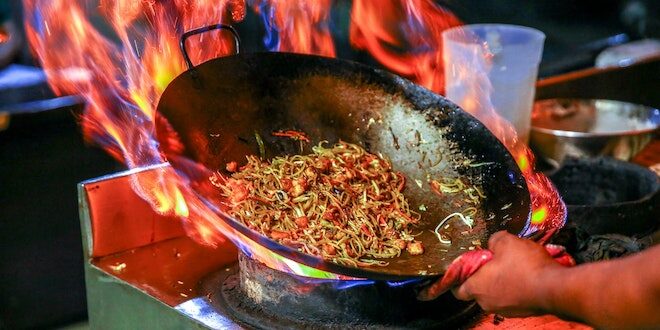Last Updated on March 17, 2023
What is Zi Char?
Zi char is a popular style of cooking in Singapore that involves wok-frying a variety of ingredients and flavours to create delicious dishes. Zi Char literally means “cook and fry” in Chinese, and the cuisine is known for its affordable prices, variety of dishes, and emphasis on wok-fried dishes. The cuisine is considered a staple of Singaporean and Malaysian food culture, and is enjoyed by people of all ages and backgrounds.
Zi Char dishes often include stir-fried vegetables, noodles, rice dishes, seafood, and meat dishes, and are usually served in communal-style portions that are meant to be shared. Some popular Zi Char dishes include sambal kangkong (water spinach stir-fried with chili paste), black pepper crab (crab cooked in a black pepper sauce), and hot (rice cooked in a clay pot with various meats and vegetables).
Zi Char is typically found in small, family-owned restaurants but it can also be enjoyed at casual dining establishments, as well as high-end restaurants. But how does zi char differ from other popular Chinese cuisines, such as Cantonese and Sichuan? In this article, we’ll explore the unique characteristics of zi char that set it apart from other Chinese cooking styles.
Key Characteristics of Zi Char
View this post on Instagram
Zi char is known for its use of fresh ingredients and bold flavours. Common ingredients include seafood, meat, and vegetables that are wok-fried with a variety of spices and sauces. The cooking process is fast and requires a high heat, which is why the wok is such an essential tool in zi char cooking. The high heat creates a smoky flavour known as wok hei, or “breath of the wok,” which is an essential element of zi char cooking.
Compared to other Chinese cuisines, zi char dishes tend to be less spicy and less reliant on complex flavours. Cantonese cuisine, for example, is known for its emphasis on freshness and lightness, with dishes such as steamed fish and stir-fried vegetables. Sichuan cuisine, on the other hand, is famous for its use of hot spices and bold flavours, such as ma la (numbing and spicy) and fish fragrant (sour and spicy). In contrast, zi char is more about balance and simplicity, with a focus on highlighting the natural flavours of the ingredients.
Zi Char Menu and Dishes
One of the unique aspects of zi char is the variety of dishes available. From seafood to meat to vegetables, there’s something for everyone on a zi char menu. Popular seafood dishes include chilli crab, black pepper crab, and salted egg yolk prawns. Meat dishes include dishes such as sambal kangkong (spicy stir-fried water spinach), cereal prawns, and har cheong gai (prawn paste chicken). Vegetable dishes include stir-fried garlic kailan (Chinese broccoli) and oyster sauce baby bok choy.
While some zi char dishes may have similar counterparts in other Chinese cuisines, such as Cantonese or Teochew, zi char dishes often have a unique twist or a specific zi char flavour profile. For example, while sambal kangkong is a popular dish in many Chinese cuisines, the zi char version may have more spice or a different blend of spices than its Cantonese or Sichuan counterpart.
Best Zi Char Delivery Options
With the rise of food delivery services, zi char is now more accessible than ever. Some of the best zi char delivery options in Singapore include Lao Li Da Pai Dang (老李大排档), New Ubin Seafood, and Keng Eng Kee Seafood. When choosing a zi char delivery service, it’s important to consider factors such as delivery speed, food quality, and menu variety.
What Makes Zi Char Unique
So, what makes zi char stand out from other Chinese cuisines? One of the unique aspects of zi char is its focus on communal dining. Unlike Cantonese cuisine, which often involves individual servings, zi char dishes are often meant to be shared among a group. This communal aspect of dining is an essential part of the zi char experience, as it allows diners to sample a variety of dishes and flavours.
Another unique aspect of zi char is its emphasis on fresh ingredients. Many zi char restaurants have live seafood tanks where diners can select their own fish or crab, ensuring that the ingredients are as fresh as possible. This focus on freshness is also reflected in the fast and high-intensity cooking style, which preserves the natural flavours of the ingredients.
Finally, the affordability and accessibility of zi char make it a popular cuisine for both locals and tourists. Zi char dishes are often priced at reasonable prices, making it an affordable option for families and groups. Additionally, zi char restaurants can be found throughout Singapore, from hawker centres to high-end restaurants, making it easy to find a good zi char meal no matter where you are in the city.
Zi Char recipe: Stir-fried Beef Hor Fun
View this post on Instagram
Ingredients to prepare Stir-fried Beef Hor Fun:
- 300g of fresh hor fun noodles
- 250g of beef (sliced)
- 2 stalks of Chinese kale (chopped)
- 3 cloves of garlic (minced)
- 1 tablespoon of cooking oil
- 1 tablespoon of dark soy sauce
- 1 tablespoon of light soy sauce
- 1 tablespoon of oyster sauce
- 1/2 teaspoon of sugar
- 1/2 cup of beef stock
- Ground white pepper to taste
Instructions to prepare Stir-fried Beef Hor Fun:
- Prepare the noodles: Soak the hor fun noodles in hot water for a few minutes to separate the strands. Drain and set aside.
- Marinate the beef: In a bowl, mix the beef slices with 1 tablespoon of light soy sauce, 1 tablespoon of oyster sauce, and a dash of white pepper. Set aside to marinate for at least 15 minutes.
- Heat up the wok: Heat up a wok on high heat and add the cooking oil. Once the oil is hot, add the minced garlic and stir-fry until fragrant.
- Stir-fry the beef: Add the marinated beef slices and stir-fry until they are browned on the outside.
- Add the noodles and vegetables: Add the hor fun noodles, Chinese kale, 1 tablespoon of dark soy sauce, and 1/2 teaspoon of sugar to the wok. Stir-fry everything together for a minute or two.
- Add the beef stock: Pour the beef stock into the wok and continue to stir-fry everything until the noodles are fully coated with the sauce and the vegetables are cooked through.
- Season to taste: Taste and adjust the seasoning as needed, adding more soy sauce or sugar if desired.
- Serve: Once everything is cooked through and the sauce has thickened, transfer the stir-fried beef hor fun to a plate and serve hot.
Do You Love Zi Char Cuisine?
Zi char is a unique and delicious style of Chinese cooking that sets itself apart from other popular Chinese cuisines with its emphasis on fresh ingredients, communal dining, and bold yet simple flavours. Whether you’re enjoying a meal at a casual zi char restaurant or having it delivered to your doorstep, there’s no denying the popularity and appeal of this beloved Singaporean cuisine. So the next time you’re in the mood for a tasty and satisfying meal, consider trying out some of the best zi char delivery options in Singapore, and taste for yourself what makes this cuisine so special.
 Travel for Food Hub The Food Blog for Travel Lovers
Travel for Food Hub The Food Blog for Travel Lovers






